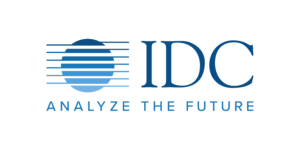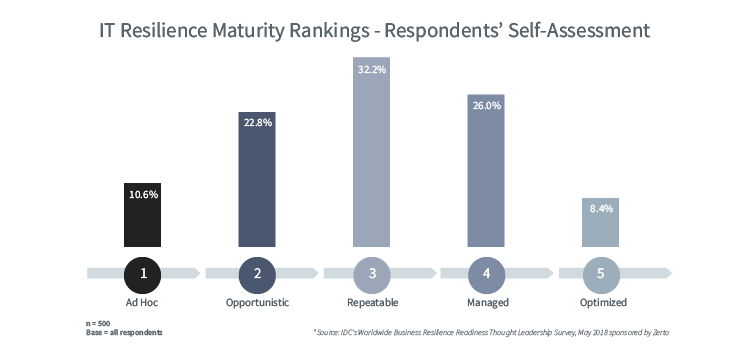

More than 90% of organizations are falling short of what is advised for IT Resilience – and in turn, they are setting up their digital transformation imperatives and their business to fail. How prepared is your organization to drive digital transformation, while ensuring there are no disruptions – whether natural disaster, ransomware, modernization or cloud migration?
Answer the 10 questions below and measure your organization against peers using Zerto’s IT Resilience Maturity Benchmark Tool. Are you Resilient and Ready?
Model based on the State of IT Resilience research from IDC, sponsored by Zerto.
1. How adequate are your IT staff levels and skills to meet your needs over the next 24 months?
2. How do you conduct physical disaster recovery(DR) testing?
3. What percent of your IT budget is spent on IT resilience hardware/software/cloud?
4. Please indicate which statement best reflects alignment of business and IT initiatives as it relates to IT resilience.
5. How important is data protection to your digital and IT transformation projects?
6. Please indicate which statement best reflects the value that your organization's business leaders place on data.
7. I am confident in my organizations ability to identify and fully recover from a tech-related business disruption.
8. Does your organization have a business resilience team?
9. How important is public cloud data protection to your organizations data protection plans?
10. During the next 12 months, which of the following IT initiatives are high priorities for your organization?
YOUR RESULTS:
Stage 1 of 5: Ad Hoc
10.6% of companies are in the Ad Hoc stage of achieving IT resilience.
For Ad hoc organizations, business and IT initiatives for IT resilience are disconnected and poorly aligned with the overall corporate strategy. They recognize that IT resilience planning is important, but actual funding and planning is pushed off for future years. Due to this lack of preparation, it is unlikely that ad hoc organizations will survive in the event of a disaster.

Recommendations to achieve IT Resilience:
- Assemble a team focused on IT resilience.
- Open communications with executive stakeholders and begin to build an IT resilience plan.
- Investigate IT resilience infrastructure alternatives.
- Consider IT best practices to embrace hybrid and multi-cloud.
- Designate IT executive sponsorship for the IT resilience plan.
Without IT Resilience Digital Transformation (and Competitors) Will Pass You By
Download the full State of IT Resilience Report:
Stage 2 of 5: Opportunistic
22.8% of companies are in the Opportunistic stage of achieving IT resilience.
For Opportunistic organizations, business and IT initiatives for IT resilience may be identified, but execution is on a project basis. Progress on bringing IT resilience to fruition is not predictable, nor repeatable. These organizations talk internally about IT resilience, but scope is limited to IT, and any plan is on paper and lacks detail. SLAs are unattainable and an organization’s ability to survive a disaster is iffy, at best.

Recommendations to achieve IT Resilience:
- Document application dependency mapping.
- Create an inventory of necessary IT resilience infrastructure.
- Consider adoption of cloud-based services for IT resilience.
- Map IT resilience responsibilities to internal stakeholders.
- Negotiate service-level requirements with executive leadership.
Without IT Resilience Digital Transformation (and Competitors) Will Pass You By
Download the full State of IT Resilience report to learn more:
Stage 3 of 5: Repeatable
32.2% of companies are in the Repeatable stage of achieving IT resilience.
For Repeatable organizations, business and IT goals are aligned at the enterprise level around the creation of IT resilience, but not yet focused on maximum and integrated IT resilience. These organizations have an IT resilience plan that is effective but requires significant manual effort and likely has long recovery times fraught with errors and restarts.

Recommendations to achieve IT Resilience:
- Develop disaster failover runbooks.
- Evaluate and acquire the necessary IT resilience solution needed to facilitate workload failover with SLA requirements.
- Leverage cloud DR and DP solutions as key pillars for an IT resilience strategy and educate the organization about the cost and functionality benefits.
- Perform threat analysis and map threats to responses.
- Establish testing protocols and write test procedures and schedules.
- Communicate test plans with IT management and LOB stakeholders.
Without IT Resilience Digital Transformation (and Competitors) Will Pass You By
Download the full State of IT Resilience report to learn more:
Stage 4 of 5: Managed
26% of companies are in the Managed stage of achieving IT resilience.
For Managed organizations, integrated, synergistic business and IT management disciplines deliver IT resilience on a continuous basis. IT resilience preparedness is an organizational commitment with IT and internal stakeholders having a coordinated plan, including scenario contingencies.

Recommendations to achieve IT Resilience:
- Write failover preflight checklists.
- Implement test simulations.
- Conduct monthly IT resilience team meetings with internal stakeholders and coordinate with change management.
- Identify cloud-based tools and services which may be absent or underutilized for IT resilience purposes.
- Conduct actual failover testing and involve internal stakeholders.
- Report the results to IT and senior management.
Without IT Resilience Digital Transformation (and Competitors) Will Pass You By
Download the full State of IT Resilience report to learn more:
Stage 5 of 5: Optimized
8.4% of companies are in the Optimized stage of achieving IT resilience.
For Optimized organizations, both business and IT leaders are aggressively disruptive in the use of new digital technologies and business models to affect maximum IT resilience. Application failover is seamless from an IT perspective, and corporate IT resilience planning is more crisis management. In the event of an actual disaster, all members understand their role and are prepared to execute on it.

Recommendations to achieve IT Resilience:
- Conduct testing with “surprise” scenarios.
- Conduct testing with secondary personnel.
- Hold postmortem meetings on test results and plan for next tests.
- Ensure that all workloads failover within specified SLAs.
- Stay current on cloud-based services and improvements to match your -organization’s unique requirements for IT resilience.
- Engage a qualified third party to audit the IT resilience test plan and report results to senior management.
- Backup and DR admins should extend their reach with complementary, integrated, and cloud-enabled solutions and services that optimize the value of organizational data and facilitate digital transformation initiatives.
Without IT Resilience Digital Transformation (and Competitors) Will Pass You By
Download the full State of IT Resilience report to learn more: